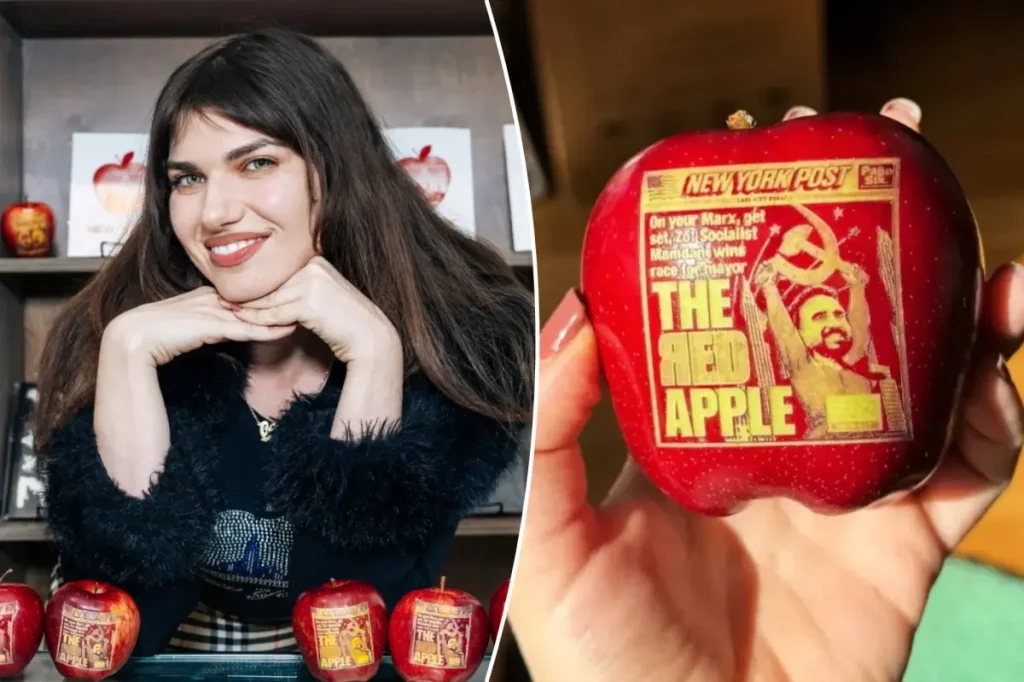An Apple a Day: How One New York Artist Turns Fruit into Front-Page News
In the heart of Manhattan, Olivia Rose spent a Thursday morning immersed in a sea of Red Delicious apples, transforming the ordinary fruit into extraordinary art. The landscape architect-turned-artist carefully engraved 80 apples with iconic New York Post front pages—ranging from JFK’s 1963 assassination to Zohran Mamdani’s recent mayoral victory—for her exhibition aptly titled “Apple Stand.” Debuting at Tribeca’s Blankmag Books to an audience of 200, Rose’s unique tribute to New York City and its beloved tabloid represents a creative way of collecting the city’s countless stories and returning them to the public through art. “There are millions of different stories that have happened in this city,” Rose explained. “This is my way of collecting those stories and giving them back to the city through my artwork.” Rather than relying on traditional carving methods, Rose employs a sophisticated $8,000 XTool F2 laser-engraving machine that completes each apple masterpiece in just under a minute and a half—a technological approach that allows her to capture the newspaper’s distinctive layouts with remarkable precision.
While the engraving process itself is relatively quick, the preparation behind Rose’s apple art requires significant dedication. She spent countless hours exploring The Post’s extensive archive, carefully selecting her favorite front pages before digitally preparing each one for engraving. This meticulous process involved uploading images to a graphics editing system, retouching covers for laser precision, and sometimes restoring damaged elements from decades-old prints. Each selected front page had to be precisely scaled down to two inches to fit perfectly on the apple’s surface. For Rose, the appeal of The Post’s covers lies in their marketing brilliance—the way they immediately capture attention without seeming overworked. “The Post’s covers are its marketing—they pull you in,” she notes. “There’s something very attractive about how the art and the writing aren’t overworked, but are still very poetic. The paper is like your friend, who’s a little out of pocket, but fun.” This characterization reveals her genuine appreciation for the tabloid’s approachable style and broad appeal.
As a lifelong New Yorker and print media enthusiast, Rose sees profound parallels between apples and The Post itself. “Like an apple, The Post has always been accessible,” she observed. “It’s meant for everybody. There are no barriers.” This accessibility theme extends to her choice of fruit as well. Rose deliberately selected apples for her artistic tribute after learning about the origins of New York’s “Big Apple” nickname, which began among jazz musicians in the 1920s and ’30s. The term referred to musicians moving to major venues (or “Big Apples”) like New York City after playing smaller towns. The nickname eventually transformed into a powerful tourism marketing tool that has become synonymous with the city’s identity. “The fruit became a symbol, a marketing tool—everywhere you go, there are things marked with ‘Big Apple.’ I really admire the city for self-branding,” she explained, drawing another connection to The Post’s distinctive branding approach.
Each apple in Rose’s exhibition represents both a moment in New York’s history and an ephemeral piece of art. While she often preserves her apple creations with a specialized sealant to delay deterioration, she intentionally left the exhibition pieces untreated. This artistic choice allows viewers to witness the natural decomposition process, adding an additional layer of meaning to the work as it comments on the transient nature of news, events, and memory. Despite their inevitable decay, these engraved apples—selling for $50 each—capture moments frozen in time, preserved through The Post’s distinctive headlines and layouts before gradually returning to nature. This intentional impermanence makes each piece all the more valuable as a fleeting snapshot of the city’s ongoing story.
Rose’s “Apple Stand” exhibition transforms the ordinary fruit into a canvas for New York’s collective memory. Each engraved apple represents not just a newspaper front page but a moment that shaped the city’s identity. From presidential assassinations to mayoral elections, these stories collectively form the unique narrative of New York. By laser-etching these headlines onto apples—the very symbol of the city itself—Rose creates a beautiful metaphor for how news and shared experiences become part of our cultural DNA. Her artistic vision brings together technology, journalism, history, and nature in a distinctly New York way, celebrating the city’s resilience and ever-evolving character through an accessible medium that anyone can appreciate.
The artist hopes her work resonates deeply with fellow New Yorkers who recognize themselves and their city in these apple-borne headlines. “This belongs to the people of New York,” Rose stated. “It represents the city’s unique fingerprint.” In transforming The Post’s bold, sometimes brash, always captivating front pages onto the humble apple, Rose has created something profoundly symbolic of New York itself—approachable yet sophisticated, temporary yet timeless, and always distinctly original. Through her innovative artistic approach, Rose captures the essence of both the city and its iconic tabloid—proving that when it comes to celebrating New York’s spirit, she’s truly got it down to the core.


